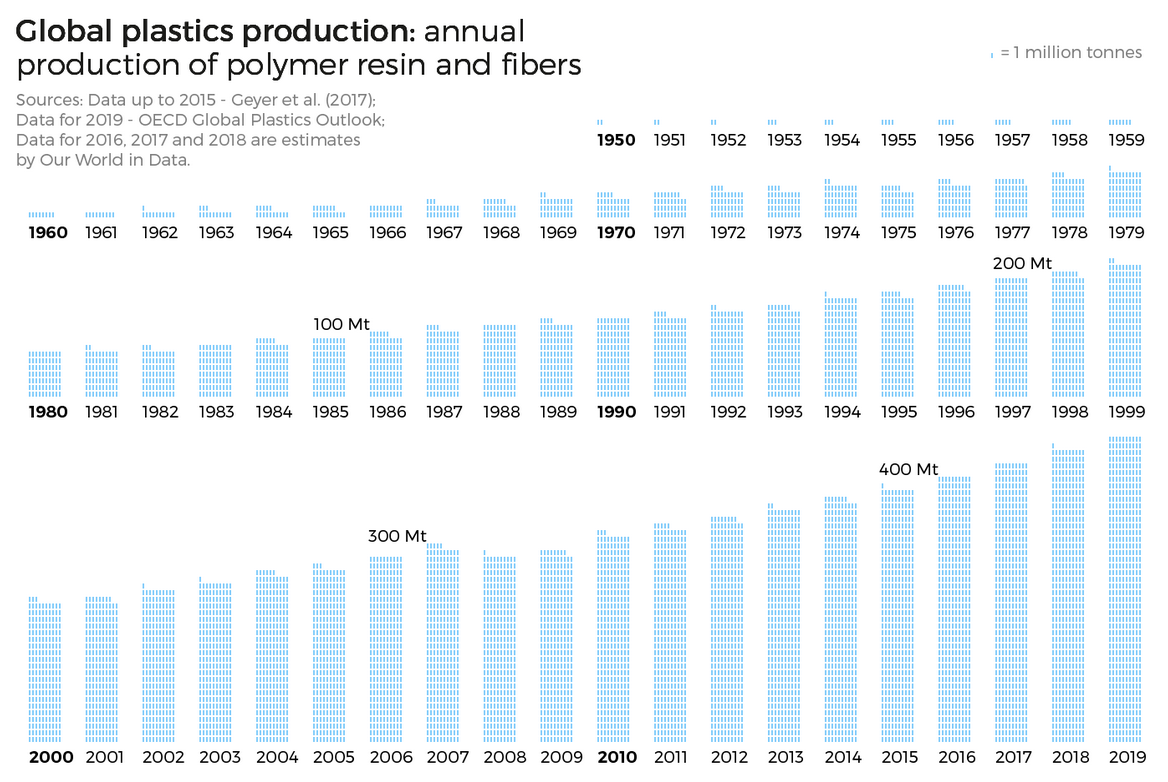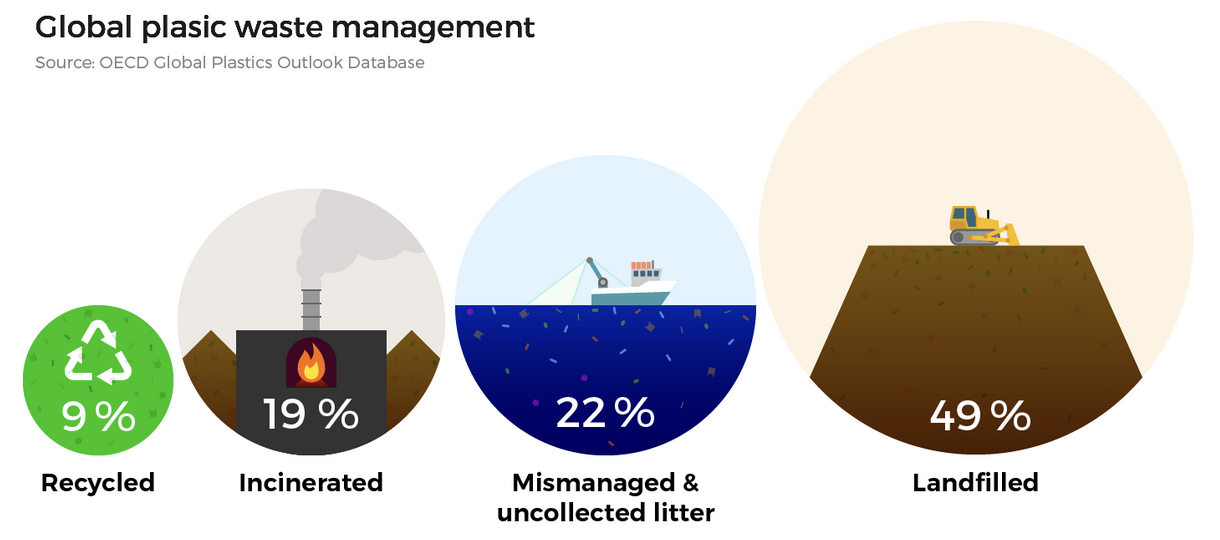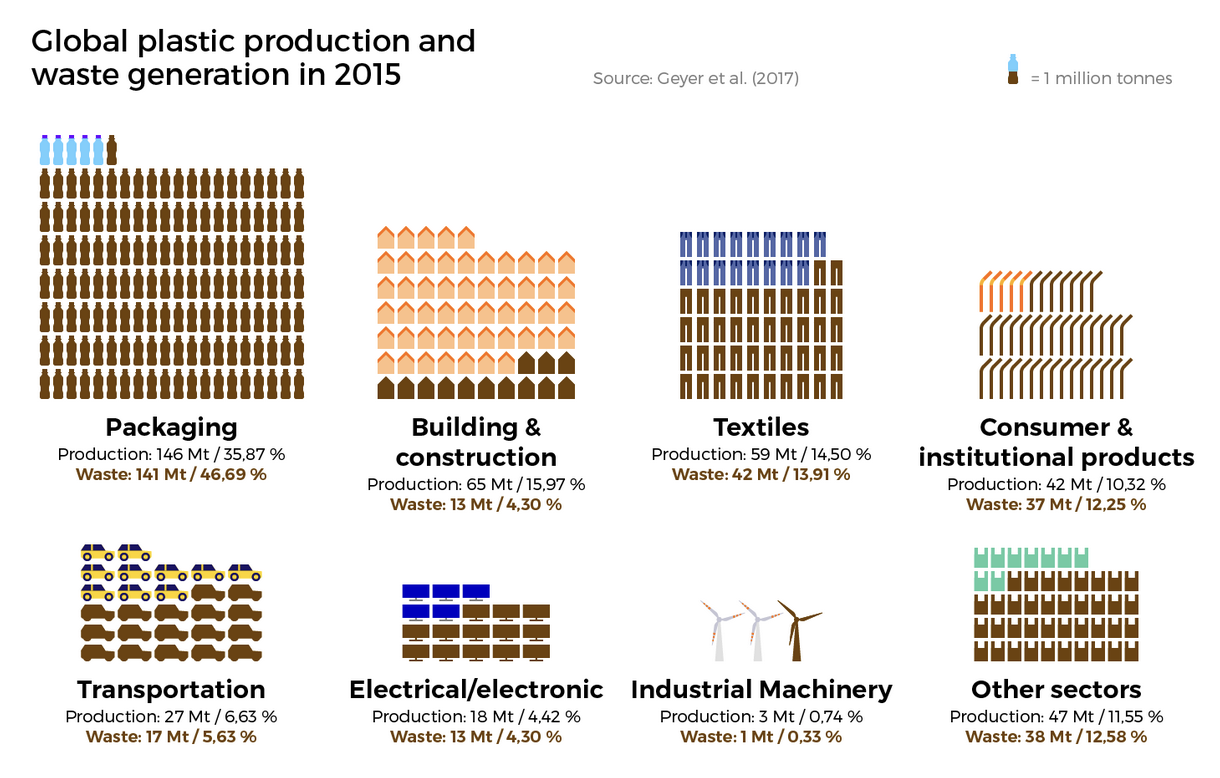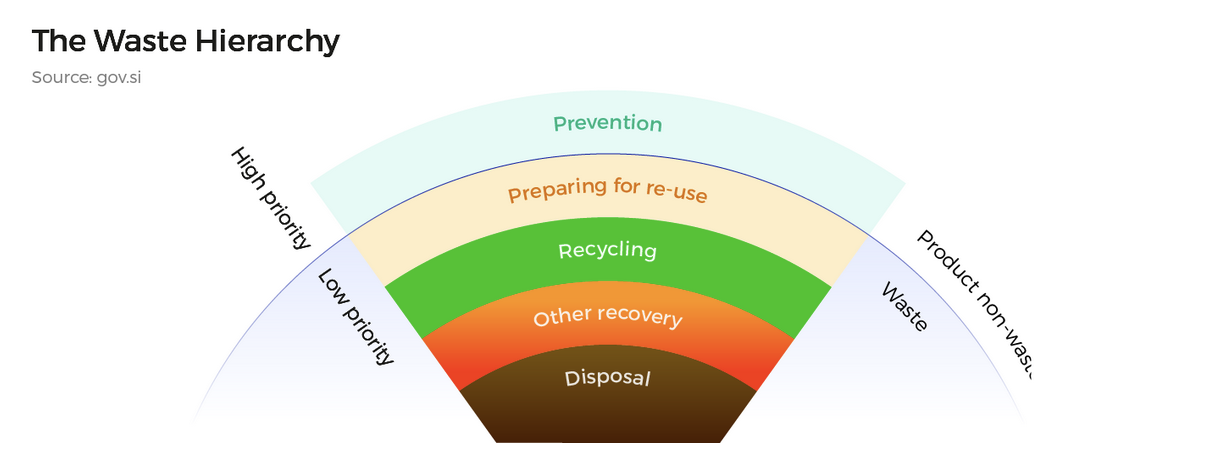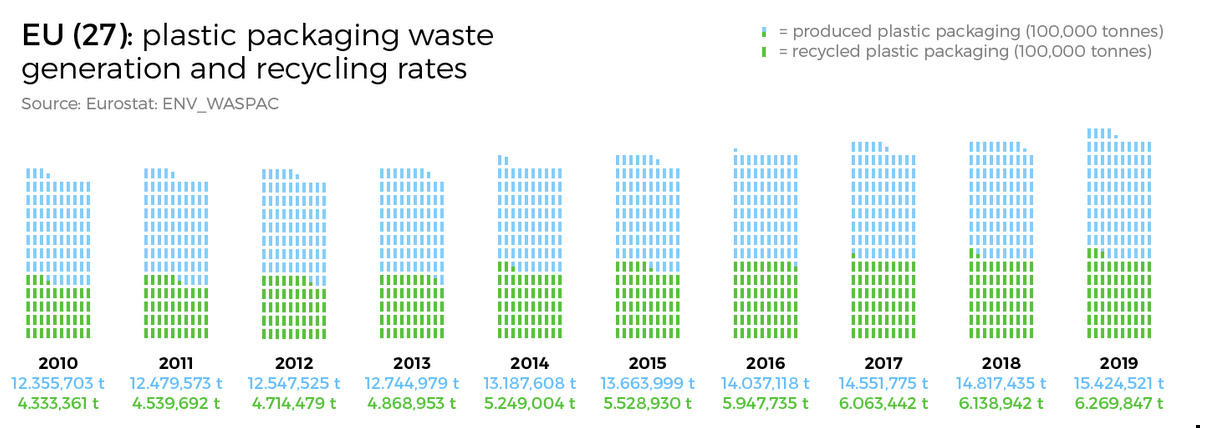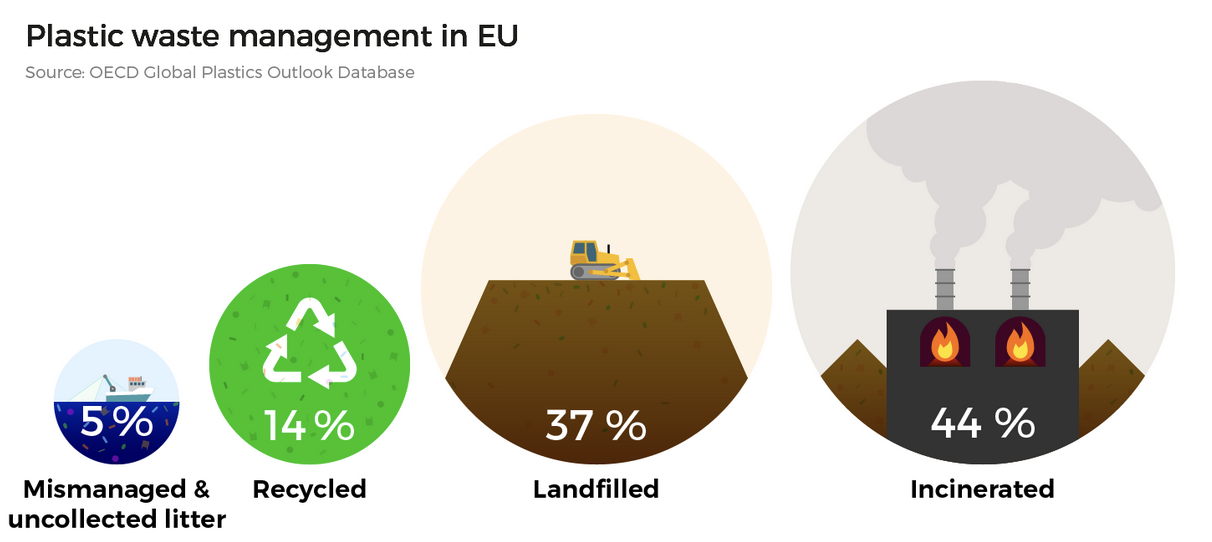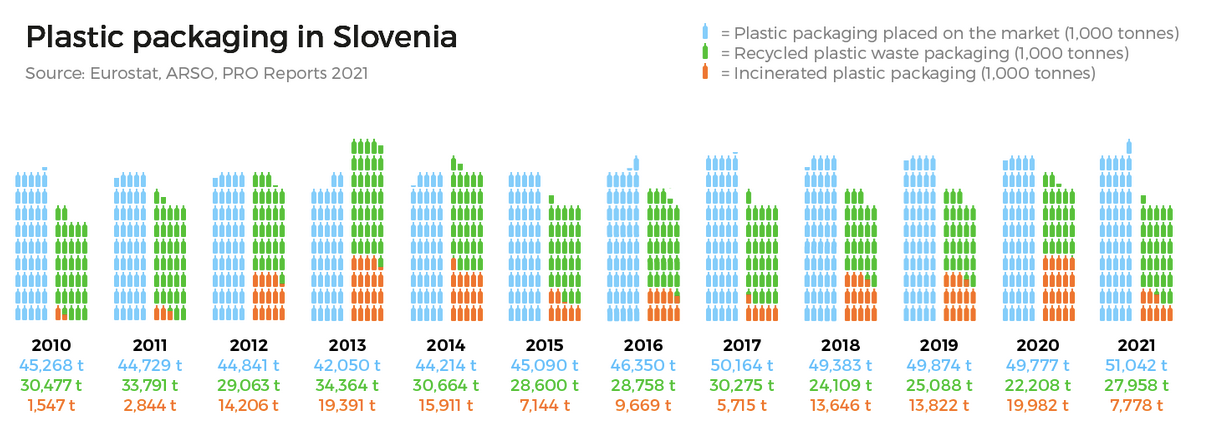Slovenia and the EU have a problem with uncollected waste
As plastic waste increases in Slovenia, the European Union, and the world, so do the difficulties in disposing of and recycling it.

© Neja Berger
Snow-covered, wet piles of waste plastic packaging are being flown around by pigeons, crows, and even seagulls when we visit Snaga, a public utility company based in Ljubljana that manages the drinking water supply, waste waters, and the waste management system, in January 2023.
The waste storage capacity is full, and so the public service provider cannot put this waste anywhere else other than the outdoors.
Jože Gregorič from Snaga estimates that, at the time of our visit in January 2023, approximately 1,500 tonnes of municipal waste in plastic packaging is needing to be picked up.
Snaga collects approximately 400 tonnes (or 33 truckloads) of packaging waste every week into its yellow bins. The collected amount must be temporarily stored, and then forwarded to the packaging-waste management system, in which the packaging is recycled, incinerated for energy use, or disposed of.
By Snaga’s estimate, the largest mass of uncollected packaging waste was at their facilities at the end of 2018 and in the first half of 2019, when more than 4,500 tonnes were waiting for collection.
The collection and removal of packaging waste, which is carried out by public service providers such as Snaga, is financed by citizens through their refuse-collection bills. From then on, the packaging-waste system should be financed by the manufacturers or those who put the packaging on the market. Manufacturers can currently choose from six packaging waste management companies that act as intermediaries to collect packaging waste from municipalities. And those companies are supposed to pick up piles of packaging, which are temporarily stored by public service providers in Slovenia, such as the piles we photographed during our visit to Snaga.
That pile is far from unique
The problem of uncollected packaging waste has been ongoing in Slovenia for no less than a decade. Thousands of tonnes of packaging have been stored in landfills across the country for so long that the waste has lost most of its potential for recycling. At the same time, these piles are both a hygiene hazard, as rats or cockroaches settle among the food remains in the packaging, and a fire hazard, due to the methane, which is produced during the decomposition of biological residues.
In 2018 and 2020, there was so much uncollected packaging waste that the state ordered the emergency removal of more than 100,000 tonnes of it through intervention laws. Taxpayers footed the bill: they paid € 16.5 million for this.
A producer-funded packaging waste management system in Slovenia was first introduced in 2000. What followed was 20 years of inadequate regulations, legal disputes between the environment ministry and companies that entered the system as intermediaries, as well as a failure to comply with the Court of Audit’s warnings. Currently the law, which is supposed to reorganise the extended producer responsibility system, is under constitutional review.
At Pod črto (‘The Bottom Line’), an investigative media outlet, we are publishing an in-depth analysis of system deficiencies in the regulation of packaging-waste management in Slovenia. This is a key problem when it comes to reducing plastic pollution, since it is plastic packaging that represents the largest share of plastic production and plastic waste.
Globally, only 9% of plastic waste is recycled
OECD data shows that 460 million tonnes of plastic were produced globally in 2019, which is 230 times more than in 1950. The latest OECD forecasts show that the amount of plastic produced and disposed of will only increase: the mass of plastic waste generated annually will triple by 2060, unless countries introduce serious changes to reverse the trend.
As the amount of plastic produced increases, so does the amount of plastic waste.
In 2019 only 9% of the 353 million tonnes of plastic waste was recycled. 50% was landfilled, 19% was incinerated, and the remaining 22% evaded waste management altogether and was disposed of in uncontrolled dumpsites, burned in open pits or ended up in terrestrial or aquatic environments. As many as 77.7 million tonnes of plastic was mismanaged or uncollected in 2019 alone, leaving it to leak into the environment where it will be decomposing for hundreds of years.
Infographic: In 2019, 9% of plastic waste was recycled, 19% was incinerated, and the remaining 22% evaded waste management altogether and was disposed of in uncontrolled dumpsites, burned in open pits or ended up in terrestrial or aquatic environments.
Most plastic waste is packaging waste, which also has the shortest lifespan and is mostly discarded after single use. Plastic packaging also represents the largest share of plastic in the oceans. In the European Union, plastics account for between 80 and 85% of marine litter, with single-use plastic products accounting for 50% and fishing-related products for 27% of all waste.
Infographic: Plastic packaging has the shortest lifespan, is mostly thrown away after one use, and represents the largest share of plastic in the oceans.
Failures of legal regulation
In international law, the issue of plastic waste is mainly regulated within the framework of waste management. There are several legal principles in the international environmental law that apply to waste management. They mostly aim to prevent environmental damage with future generations in mind, and to impose a responsibility for environmental damage on the companies that cause it.
The European Union is a world leader in the field of ecological and sustainable development and waste management. Its many directives in this field oblige member states to achieve certain environmental goals.
Several directives establish a hierarchy of waste management, on the basis of which member states are supposed to take action. The hierarchy places the prevention of waste first, followed by measures for reuse – and only then recycling and other methods of handling. The EU Directive on Packaging and Packaging Waste also stipulates that countries should implement preventive measures to curb the production of packaging waste.
The waste management hierarchy does not require specific policies from EU member states within certain time limits. It acts more like a non-binding principle according to which the states should formulate measures. Most of the legally binding guidelines regulate the low-priority area of waste management. One of the exceptions is the directive on the reduction of the impact of certain plastic products on the environment, adopted in 2019, which explicitly prohibits certain plastic products and restricts others.
However, the history of directives regulating the low-priority area of waste management, which is the focus of this article, is longer.
One of the more specific environmental goals set by the EU for member states comes from the Directive on Packaging and Packaging Waste, adopted in 1994. The latest goals of this directive, updated in 2018, state that countries must recycle 50% of plastic packaging by the end of 2025, and 55% by the end of 2030.
The directive also stipulates that countries must encourage an increase in the proportion of returnable packaging placed on the market, as well as systems for the reuse of packaging in an environmentally safe manner, which may include deposit schemes, economic incentives, targets, setting minimum percentages of returnable packaging for each type. However, these provisions do not dictate specific measures and deadlines, but only indicate the possibilities of specific policies.
According to Eurostat data, the amount of recycled packaging waste increased between 2010 and 2019. However, the total production of plastic packaging has also increased.
Infographic: In 2019 we recycled more tonnes of plastic than in 2010, but paradoxically, despite the growing awareness of the issue, we produced more tonnes of non-recycled plastic waste than in 2010.
The trend of increasing recycling rates in the European Union is therefore not keeping up with the increase in the amount of plastic packaging placed on the market. While the recycling rate is increasing in accordance with the European directive, the goal of preventing waste generation – which should represent the highest priority according to the hierarchy presented above – is not being met.
In practice, this means that in 2019, the EU-27 countries recycled more tonnes of plastic than in 2010, but paradoxically, despite the growing awareness of the issue, generated more non-recycled plastic waste than in 2010. Waste that is not recycled is either incinerated to obtain energy or disposed of (which can include incineration or landfill).
Slovenia has already transposed regulations on packaging waste from the above-mentioned European directives into legislation, namely with two decrees on packaging waste plus the Environmental Protection Act (of which the third version is currently in force).
According to official data provided by Slovenia to Eurostat, the amount of plastic waste is also increasing in Slovenia. In 2004, Slovenia produced almost 40,000 tonnes of plastic waste, and in 2019 and 2020, almost 70,000 tonnes each year. Most of this, almost 50,000 tonnes, was plastic packaging.
Since 2013, the production of plastic packaging waste has increased in line with the global trend, while the share of recycled packaging waste has decreased, according to the official data. While in 2013 Slovenia officially put 42,000 tonnes of plastic packaging on the market and recycled more than 80% of this mass, in 2021 the country officially produced 51,000 tonnes and recycled 55%.
We asked ARSO (the Slovenian Environment Agency) why, according to the official data that Slovenia provides in reports to the European Commission, Slovenia recycled as much as 80% of all waste plastic packaging (more than 34,000 tonnes) in 2013, and yet in 2021, the figure had fallen to 55%. This also represents a smaller amount in terms of mass – a little less than 28,000 tonnes.
A spokesperson for ARSO replied, noting that the category of recycling in Slovenian legislation has not changed significantly, but the rules for calculating and verifying the achievement of goals and reporting data have, most recently with the amendment of the European directive in 2019. Before the amendment, only the predominant material in composite packaging was measured and the others neglected. After 2019, each material in composite packaging is measured separately and reported to the Commission. The reduction in the share of recycled plastic packaging may also be partly the result of upgrading the data collection system and introducing new data controls, they added.
This is the first of a four-part investigation: read part 2, part 3 and part 4.

